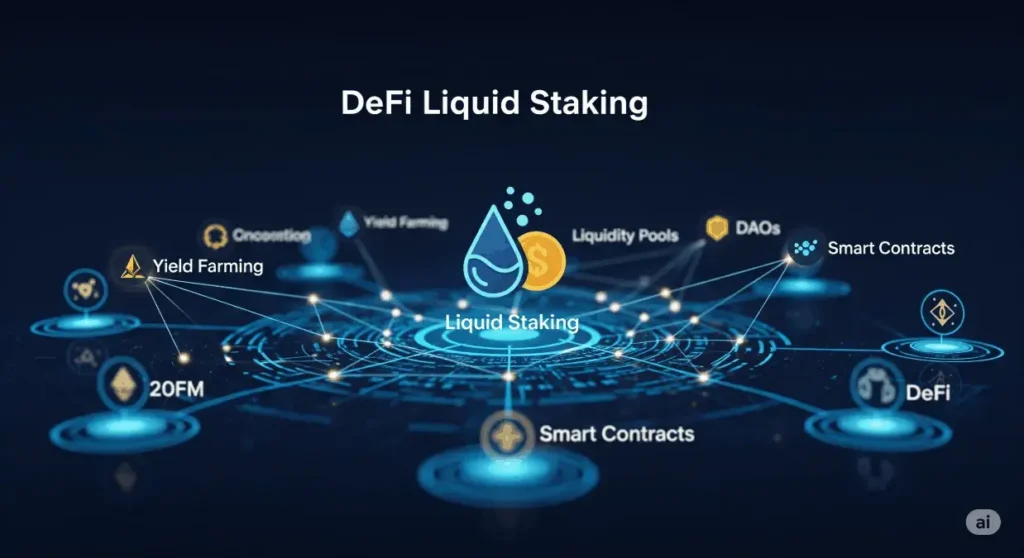DeFi Liquid Staking: Unlocking Capital Efficiency in Decentralized Finance

For years, staking has been a cornerstone of Proof-of-Stake (PoS) blockchains, offering a way for network participants to earn passive income by securing the network. Traditional staking, however, came with a significant drawback: illiquidity. Assets were locked for a specific period, making them unavailable for other financial activities. This created a dilemma for users—either earn staking rewards or participate in the dynamic world of Decentralized Finance (DeFi). The emergence of liquid staking protocols has revolutionized this landscape, offering a solution that combines the best of both worlds.
Liquid staking allows users to stake their crypto assets and, in return, receive a “liquid staking token” (LST). This token is a representation of their staked assets plus any accrued rewards. Crucially, these LSTs are not locked and can be used freely in the broader DeFi ecosystem. This innovation has unlocked trillions of dollars in value, making staked assets highly capital-efficient and paving the way for a more dynamic and interconnected DeFi environment.
How Liquid Staking Works: A Step-by-Step Guide
The mechanism behind liquid staking is both elegant and powerful. When a user deposits their assets (e.g., ETH) into a liquid staking protocol like Lido or Rocket Pool, the protocol stakes these assets on the user’s behalf. The user then receives an LST (e.g., stETH or rETH) in their wallet.
This LST is pegged to the value of the original staked asset and its rewards. For example, if you stake 1 ETH and receive 1 stETH, the value of that stETH will increase over time as it accrues staking rewards. The original ETH remains locked, securing the network and earning rewards, while the stETH can be used for a variety of purposes:
- Yield Farming: Providing liquidity to decentralized exchanges (DEXs) like Curve or Balancer.
- Lending and Borrowing: Using the LST as collateral on lending protocols like Aave or Compound.
- Trading: Swapping the LST on the open market for other cryptocurrencies.
When a user wants to “unstake” their original assets, they simply return the LST to the protocol, which then facilitates the withdrawal of their original tokens.
The Key Players in the Liquid Staking Arena
The liquid staking market has grown to include a number of prominent protocols, each with its own unique approach and features. Lido Finance, for example, is the largest player in the space, particularly for Ethereum, with a significant market share. Its stETH token is widely integrated across the DeFi ecosystem.
Rocket Pool, another major protocol, emphasizes decentralization by allowing anyone to run a node, thereby lowering the barrier to entry for solo stakers and distributing control more broadly. Platforms like Jito on Solana have also gained traction by incorporating Maximum Extractable Value (MEV) rewards, offering an additional layer of yield for stakers.
The variety of platforms and approaches provides users with different options based on their risk tolerance, technical expertise, and desire for decentralization.
Benefits and Risks: A Balanced View
Liquid staking has emerged as a cornerstone of modern DeFi, but it is not without its own set of advantages and challenges.
Benefits of Liquid Staking
- Enhanced Liquidity: The primary benefit of liquid staking is the ability to maintain liquidity. Users can put their staked assets to work in other DeFi protocols, multiplying their potential returns.
- Increased Capital Efficiency: By earning staking rewards and simultaneously generating additional yield from DeFi, users can achieve a higher overall return on their capital.
- Lower Barrier to Entry: Many liquid staking protocols eliminate the high minimums required for solo staking, democratizing access to staking rewards.
- No Unbonding Period: Unlike traditional staking on some blockchains, liquid staking often allows for instant liquidity, enabling users to exit their position quickly.
Risks to Consider
- Smart Contract Vulnerabilities: The entire process relies on complex smart contracts. A bug or exploit in a protocol’s code could lead to the loss of user funds. It is essential to choose protocols that have undergone rigorous security audits.
- De-pegging Risk: The LST is designed to maintain a 1:1 peg with the underlying asset. However, during periods of high volatility or market stress, this peg can temporarily break, leading to market risk for LST holders.
- Centralization Concerns: The concentration of staked assets in a few dominant liquid staking protocols raises concerns about the centralization of PoS blockchains. This can pose a systemic risk to the network’s security and decentralization.
- Slashing Penalties: While users don’t run the validators themselves, they are still exposed to slashing risk. If the node operators used by the protocol misbehave, a portion of the staked assets can be “slashed,” resulting in a loss for the staker.
The Future of Liquid Staking and Beyond
As the DeFi ecosystem matures, the role of liquid staking is set to become even more integral. New innovations, such as restaking protocols, are building on top of the liquid staking model, allowing users to reuse their LSTs to secure additional networks and earn even more rewards. This creates a powerful synergy that further enhances capital efficiency and utility.
Stay informed, read the latest crypto news in real time!
The regulatory landscape is also evolving. The SEC’s Division of Corporation Finance issued a staff statement on Tuesday, declaring that properly structured liquid-staking protocols and their receipt tokens generally do not constitute securities under U.S. law. This clarity has led to modest upticks in token prices and protocol activity. Lido’s governance token, LDO, rose by approximately 4.5%, from $0.88 to $0.92, before retreating to support. Similarly, Rocket Pool’s RPL token climbed 10.5%, reaching $7.28 from $6.59, before also giving up some gains. As the space continues to mature and new solutions emerge, liquid staking will undoubtedly remain a crucial tool for unlocking the full potential of DeFi.





One thought on “DeFi Liquid Staking: Unlocking Capital Efficiency in Decentralized Finance”